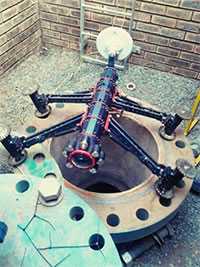Ryonic Robotics integrate Perle Ethernet Extenders in Pipeline Inspections Vehicles
Transmission speeds of 25Mbps reliably achieved over 1000m coax cable in pipelines
Pipelines are the most efficient way to transport oil, gas and other liquids. There is an estimated 3,500,000km of pipelines in 120 countries around the world, with another 190,000km planned or under construction*.
Maintaining a safe and clear pipeline is of utmost importance to it operators, as blockages or other disruptions are extremely costly and lead to loss of supply and environmental catastrophes.
Internal pipeline inspections are part of the routine maintenance procedures for pipeline operators. Ryonic Robotics has developed the RMIS Inspection Crawler, an unmanned ground vehicle (UGV) to carry out pipeline & confined space inspections, mine shaft and tunnel inspections, oil rig riser and other vertical inspections, as well as, autonomous surveillance for security and military.
The RMIS crawler is fitted with various cameras, lasers and sonar sensors to create 3D models of the space through which it moves. They are integrated with a Virtual Reality (VR) system that the operator can use to “walk through” the pipe and examine any weld or flaw in further detail.
Rick Montgomery, Lead Roboticist at Ryonic explains, “We manufacture robotic inspection crawlers that can do all manner of underground or underwater pipes including storm water and drainage pipes for infrastructure. Traditionally, in the robotic pipeline inspection environment, the robotic crawler will have a power and communication tether that is towed behind it as it traverses inside the pipe. To transmit power and data as the length of the tether cable increases becomes more and more difficult. Power is not so difficult but data communication is the key to the whole exercise.”

Ryonic Robotics needed to increase the Ethernet data communication distances of their unmanned vehicles but did not want to incur the huge costs of upgrading to a fiber-optic infrastructure. Since the RMIS crawler already used coax cabling, Rick Montgomery researched the concept of installing Ethernet Extenders, with some key requirements in mind.
- They would need to be capable of transmission speeds of 25mbps over 1000m.
- They would need to be lightweight and physically small as they would be mounted on the vehicle itself.
After testing equipment from several vendors in their labs, Ryonic Robotics chose Perle Ethernet Extenders due to their small size, light-weight and high data speeds.

Montgomery comments, “Standard copper tether is still very viable if you can get the data rate. That is where the Perle technology comes in hand. So, in the end we do not make use of expensive fiber but we use copper with Perle’s DSL technique to get the required bandwidth at the distance of 1000 meters.”
About Ryonic Robotics:
Ryonic Robotics, based in Johannesburg, South Africa, was founded in 2014 and is at the forefront of developing the latest robotics technology in the world. The Company’s first major project was the RMIS inspection crawler that is aimed at the Pipeline, Oil & Gas industries. Other current projects include a magnetic ship hull cleaning robot and a Cobot worker for factory automation and other applications. Ryonic Robotics is a member of the Reunert group.

*Pipeline Transport. Wikipedia. 5th June 2017. Web